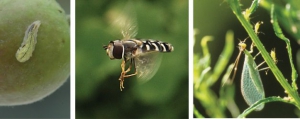
Left: Syrphid fly (also known as hover fly) larvae or maggots like this are voracious predators of aphids. Center: Syrphid flies feed as adults on pollen and nectar, while their larvae are important predators of aphids in orchards. Right: Green lacewing feeding on aphids.
Left, center: PHOTO BY ELIZABETH BEERS, WASHINGTON STATE UNIVERSITY. Right: PHOTO BY ELIZABETH BEERS, WASHINGTON STATE UNIVERSITY
At present, most of the models that have been developed and are available through information delivery technology, like the Washington State University Decision Aid System (http://das.wsu .edu), are for pest insects. This led our research team to wonder: Could we develop similar models for important natural enemy species in western orchards? These models could then provide a better understanding of when natural enemies are present and aid in reducing nontarget effects of management practices, like the application of pesticides, on beneficial populations.
How do we make a model?
Models utilize the strong relationship between insect development and temperature. This means that, within limits (called lower and upper temperature thresholds), the warmer the temperature the faster the insect develops. Beyond these temperature thresholds, insect development stops. Models are based on the fact that each life stage of an insect requires a certain number of heat units called degree-days (DD) to be completed. The number of degree days required for the completion of a certain life stage is determined in laboratory experiments and/or through monitoring an insect population at several locations over two or more seasons and relating the observations to site-specific temperature data. After an insect model is developed, it needs to be validated with additional field observations to make sure that the predictions match observed events in the insect’s life history.
Over the past four years, we were able to consistently monitor certain natural enemy populations throughout the entire season using traps with herbivore-induced plant volatile (HIPV) attractants. (See part 2 of this series, “Natural enemy inventory,” in the February 15 issue).
From the monitoring data, we have developed models for two species of lacewings (Chrysoperla carnea and Chrysopa nigricornis), a syrphid fly (Eupeodes fumipennis), and the mirid bug, Deraeocoris brevis. All of these natural enemies are important predators of aphids, pear psylla, pest mites, mealybugs, and other soft-bodied insects. Over the next few years, we will work on validating these four natural-enemy models. Once we are confident in the accuracy of the models, we will begin to integrate them into the WSU Decision Aid System, where they will be readily available to decision makers.
How can the model be used to conserve natural enemies?
Once we are able to predict when a natural enemy should be present in the orchard, management practices can be adjusted to help conserve their populations and, consequently, their biocontrol services. A model tells when a specific natural enemy emerges after the overwintering period, when its peak activity occurs, and how many generations occur per season. This information can help decision makers identify windows of opportunity where they can alter spray timing or, if that is not possible, select lower-risk pesticides to avoid negative impacts on a natural enemy population. Simply put, if pest models are used to better target and treat pests, then natural enemy models can be used in a similar manner to conserve these beneficial insects.
Can natural enemy models be used to evaluate spray programs?
While collecting the data used to generate models, we also gathered spray records for each orchard location over a three-year period. We found that data in some orchards did not fit our model where sprays were used at certain times of the year or when certain pesticides were used. For example, our data showed that some pesticides strongly delayed the expected appearance of a natural enemy or, in some cases, resulted in an entire generation being missing. We also found that typical early season sprays (especially lime sulfur plus oil) in apple, pear, and sweet cherry are applied multiple times during a period when some important natural enemies are emerging in the spring. This means that the natural enemies are exposed to these pesticides throughout the adult stage, as well as during the egg and larval stages of their first generation. Traditional thinking has been that these sprays occur when natural enemies are not present, but our research has shown otherwise.
Over the next year we will be pursuing the idea of using these models to better understand the effects of pesticides on natural enemies in commercial orchards. As part of our Specialty Crop Research Initiative-funded project, we have evaluated the effect of a few different spray programs in apple, pear, or walnut orchards on natural enemies and their pests in large-plot field experiments. However, it is difficult to look at a wide variety of spray programs using this approach, as it is labor and resource intensive. With the natural-enemy models and HIPV lure traps, we now have an efficient way to sample multiple commercial orchards, allowing us to assess a broader range of pesticides and application timings.
Ultimately, once these new models and monitoring tools are available, pest management decision makers will be able to compare their own spray programs in different blocks or across different orchards to see the potential impacts on different natural enemies. The accessibility and use of natural enemy models and monitoring tools could have a tremendous impact on conserving natural-enemy populations and improving biological control in western orchards.
This is the third article in an eight-part series highlighting results of a five-year Specialty Crop Research Initiative project to enhance biological control of orchard pests. The project involves researchers from Washington State University, Oregon State University, University of California Berkeley, and the U.S. Department of Agriculture in Yakima, Washington.
Leave A Comment